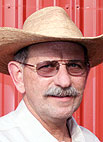
Dan Corman’s association with Charolais cattle began when he was 5 years old. “In the fall of 1958, I traveled with mom and dad, C.R. and Joanna, to Chillicothe, Mo., where we purchased a 7/8 Charolais bull,” Dan recalled. “Dad wanted to increase the frame size of our basic commercial cow herd.”
History
When they brought the bull home to the farm in Pomona, Mo., he was the first Charolais bull in Howell County if not all of south central Missouri. “We’ve been using Charolais bulls since then,” explained Dan. “We’ve kept our best heifers to increase our herd, culled the cows that didn’t produce or have the right disposition and since 1974, Corman Charolais has exclusively used polled Charolais bulls.
“At a time when the United States beef herds are generally black, we have found the hybrid vigor gained from breeding Charolais bulls with the British breeds allows a weaning weight and feedlot weight advantage for producers. So in the end, we are helping put more profit back in our customers’ pockets with our Charolais bulls.”
Dan and his wife, Connie, now own 40 females and one herd sire with three yearling bulls for sale and four weaned bulls; with a foundation of animals from his parents herd. “Our philosophy has really not changed over the years. We strive to produce polled, easy-fleshing, moderate-framed cows that raise their calves on the available forage resources,” Dan explained.
“Some of our pedigrees in the herd trace back 15 generations for Corman Charolais,” he added.
“Charolais have good maternal ability and can raise a good calf on the forages available here in the Ozarks. A calf’s weaning weight, without creep feed, is a reflection of the cow’s natural milking ability. We have always felt a cow should wean off a moderate size calf, while maintaining body condition and breeding back in a timely manner,” Dan explained, “and do so on the grass and forages available with not a lot of additional supplements. That’s what our Charolais cows are doing for us.”
Breeding and Calves
“We use artificial insemination to improve the genetics with some of the top bulls in the breed,” explained Dan. “We maintain quality herd bulls for natural clean-up service following AI. Cows and heifers are synchronized and we use timed breeding to calve in late February through April, in a tight 60-day period and have fall calving cows in late August through October.”
At Corman Charolais, all calves are weighed at birth, at weaning and as yearlings, to assist with EPD numbers to help them build the strongest genetics they can. “We generally process our calves with the first round of shots two to three weeks prior to weaning or at about seven to eight months of age,” explained Dan.
“When calves are weaned, they are weighed and receive a second round of shots and parasite controls under the direction of a local veterinarian,” he said. “We also utilize branding for additional identification purposes.
“At weaning, bull and heifer calves are separated and begin specialized programs to take advantage of their growth potential. Bulls start a growing ration and at 12-14 months they are weighed and semen tested,” he explained. “We also gather scrotal circumference information at this time. This gives our bull buyers the information they want to review before making a decision to purchase our bulls.
“At the same time, the heifers are penned separately and given pasture access for a forage-based ration with a small amount of grain to aid in growth. Having them in a separate pen and feeding grain, allows me the option to work around them and ensure quiet handling ability and gentle disposition,” Dan explained.
“To be profitable, we want our heifer calves to be able to be bred easily,” he said. “So at 12-14 months, when we test the bulls, heifers are also weighed and at 15 months of age we have our vet give them a pelvic tract exam. We want to do all we can on our end to make sure Corman Charolais cattle are prepared for a future of production, whether as a herd sire or a cow on the farm. Either way, we want our customers to be happy with the quality of cattle they receive from our farm.”
Forage
“Part of our cattle philosophy includes cattle growing on the forage they have available and that is an essential part of our operations,” explained Dan. “On our farm, we typically grow fescue for fall, winter and spring grazing. We have Bermudagrass for summer pasture and utilize an alfalfa/orchard grass mix for hay and some grazing.
“Due to the drought last year, we had to utilize fall seeding of annual rye grass and also wheat and turnips to extend the grazing season,” Dan added.
Marketing
“We typically sell our breeding bulls by private treaty to commercial breeders within a 100-mile radius of Pomona,” recalled Dan. “Most of those sold are 14-18 months of age, and we also consign some bulls to a local breeder’s bull sale each March.
“Our females are consigned to the Annual Renaissance sale held each April and the Autumn in the Ozarks sale each Labor Day, both in Strafford, Mo.,” he explained. “They sell as cow/calf pairs and we rarely sell females private treaty.”
Corman Charolais have been raising and selling quality Charolais for 55 years and they’ve been raising beef cattle in Howell County for longer than that. “I don’t see any reason we’d make many changes,” reasoned Dan. “We have a smooth operation and I have enjoyed raising my family on the farm and now it’s exciting to see my granddaughter come back to the farm.”
Dan and his wife, Connie, have two daughters and one granddaughter, Mallory, with another grandchild on the way in November.







